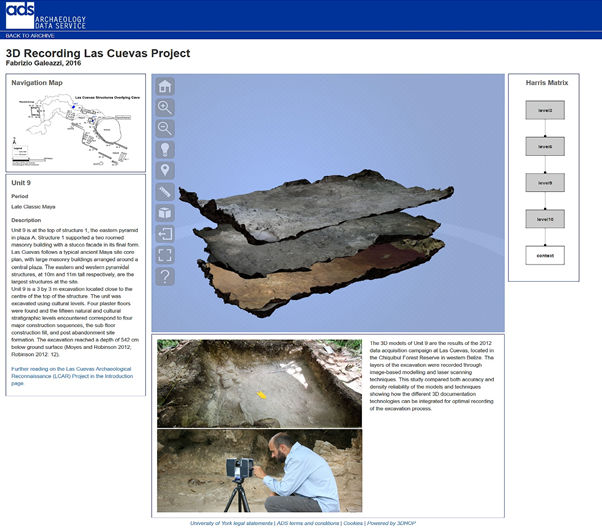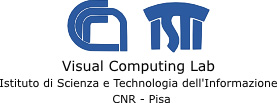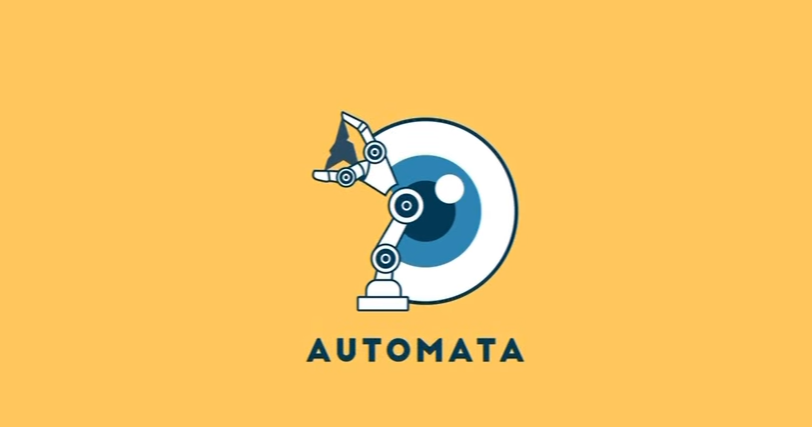The ADS 3D Viewer was a two year project funded under the Marie Curie Actions Seventh Framework Programme, and benefited from the collaboration with the Visual Computing Lab (ISTI-CNR) in the framework of the ARIADNE European project. The project had the overall aim of developing a 3D web-based working environment for the management and analysis of archaeological data, based within the Archaeology Data Service.
ADS 3D Viewer was designed to investigate how the adoption of WebGL (Web Graphics Library) by current web browsers can support the development of an open access infrastructure for the management and analysis of archaeological data. The aim of the interactive 3D platform (3D viewer) was not just the visualization of 3D archaeological data, but also the creation of an effective tool for the analysis and interpretation of the archaeological record. Thanks to ADS 3D Viewer multiple experts can share and analyse 3D replicas of the archaeological excavation record, which can now be revisited and subjected to new analytical techniques over the long term.
In the past twenty years the use of new technologies for the 3D documentation and reconstruction of cultural heritage has changed how we approach archaeological research. The growth of information technology in 3D documentation tools, including electronic surveying instruments, laser scanners, photogrammetric cameras, and even CAD modellers, has brought an exponential increase in the use of digital data. The use of real-time survey software and hardware such as the total station, global positioning systems (GPS), photogrammetry and laser scanners has had a remarkable impact on archaeological recording as well as important implications for archaeological survey. The use of these techniques, by improving the accuracy and precision of the documentation process, is considerably changing the nature and implications of the word digital in archaeology. Presently, the main challenge for archaeologists and information and communication technology specialists consists in the preservation and dissemination of 3D data in archaeology. Up to now, a number of 3D digital data archives have been developed but most focus on the preservation of the information over time without thinking about the accessibility of these data on the part of the scientific community.
The ADS 3D Viewer project filled this gap by developing an interactive visualization system that is integrated with the database and provides access to data archived in a simple way for all kinds of users, including those who are unfamiliar with these technologies. Using the ADS 3D viewer researchers can now analyse and interpret the archaeological record not just from text information and 2D representations of the archaeological excavation, but by interacting in real-time with high resolution 3D realistic and metric reproductions of the archaeological units. The possibility to share complex 3D models of archaeological sites and monuments, and the interpretations made by archaeologists during the excavation process on the web, will promote discussion between scholars and represents a revolutionary change in the discipline.
Two versions of the viewer have been developed to answer the needs of different users:
1. Object Level 3D Viewer
The first accomplishment of the ADS 3D Viewer project has been the development of an object level version of the viewer that extends the web-based browsing functionality of the ADS project archives with dynamic visualization of the available data. Each project archive has a short introduction of the project and a download section. In the download section it is possible to view project data produced in different file formats, such as JPG (2D images) and ASCII and OBJ (3D data). Before the development of the ADS 3D Viewer it was only possible to interrogate excavation archives by downloading individual files and reassembling the 3D geometry of the site, which demands a high level of IT skills and access to software by the end user.
The first version of the ADS 3D viewer exploits the 3DHOP tool and was tested using the 3D data of the Virtual Amarna Project archived in ADS. The 3D viewer offers users the possibility to interact with and analyse the 3D model in the 3D window embedded in the download web-page of the project, but also in full-screen mode using a trackball and different features (viewpoint, zoom and lighting). Now thanks to the ADS 3D viewer users can now browse 3D geometry directly in the webpage containing all the information related to the digital model.
2. Stratigraphy 3D Viewer
The second version, the Stratigraphy 3D Viewer, is an extension which allows the exploration of a specific kind of aggregated data: the multiple layers of an archaeological stratigraphic sequence. Before the development of the 3D viewer the ADS repository stored the 3D models of each stratigraphic unit as single objects, without the possibility to explore their spatial and temporal relationship. The Stratigraphy Viewer aggregates the different geometric layers of archaeological stratigraphy into a single 3D environment, whereby the user may turn layers on and off, control their transparency, and explore the layered geometry using a simple mouse- or touch-based navigation mechanism, specifically designed to manipulate these kind of geometries (Fig). This allows those unable to participate directly in the fieldwork to access, analyse and re-interpret the archaeological context remotely.
The ADS 3D Viewer infrastructure aims to contribute to an ongoing commitment of the European Research Council to support cyber-infrastructures which enhance and promote access to and preservation of European Cultural Heritage.
The ADS 3D Viewer is the first example of a web-based visualization system for the preservation and analysis of archaeological stratigraphy integrated within the framework of a trusted digital repository. One of the main strengths of the viewer is its flexibility and adaptability. The ADS Stratigraphy 3D Viewer can be adapted and applied to case studies that use different excavation methods (i.e. arbitrary or stratigraphic). Moreover the structure of the viewer and the partition of 3D data can be adapted to case studies that require different visualization and organisation of the archived data.
One of the primary goals of the ADS 3D Viewer project was the development of a tool that could have a significant impact upon archaeological practice, integrating both traditional and innovative data acquisition methods. The ADS 3D Viewer will help us understand if the effective integration of 3D technologies in day-to-day fieldwork practice is really possible, favouring the ‘digital turn’ in the archaeological recording on site.
By increasing the accessibility of digital and metric 3D representations of the excavation process and facilitating the interpretations made by different scholars of the same context on the web, this research has the potential to transform the discipline, allowing inter-disciplinary, cross-border and ‘at-distance’ collaborative workflows, and enabling easier access to and analysis of archaeological data.
For more information see:
Galeazzi, F., Callieri, M., Dellepiane, M., Charno, M., Richards, J.D. and Scopigno, R. (2016) ‘Web-based visualization for 3D data in archaeology: The ADS 3D viewer’, ”Journal Archaeological Science: Reports” 9, 1-11. Available https://doi.org/10.1016/j.jasrep.2016.06.045
Project partners
Archaeology Data Service, University of York
Visual Computing Lab, ISTI-CNR
Primary contacts
Fabrizio Galeazzi, Department of Archaeology, University of York
Julian Richards, Department of Archaeology, University of York
Collaborators
Marco Callieri, Visual Computing Lab, ISTI-CNR
Michael Charno, Archaeology Data Service, University of York
Matteo Dellepiane, Visual Computing Lab, ISTI-CNR
Kieron Niven, Archaeology Data Service, University of York
Roberto Scopigno, Visual Computing Lab, ISTI-CNR







